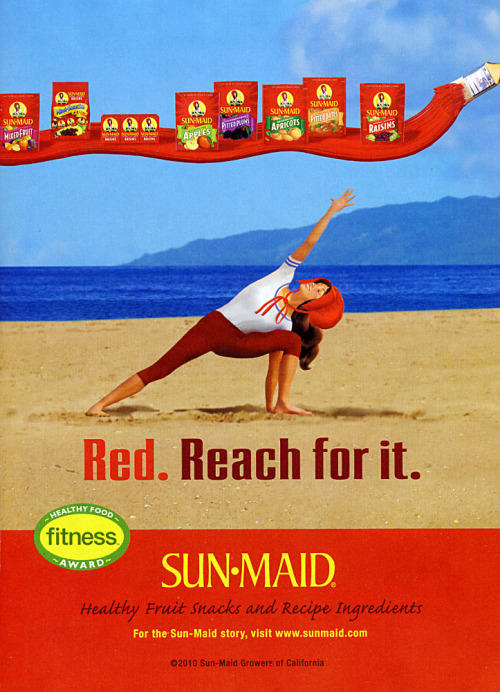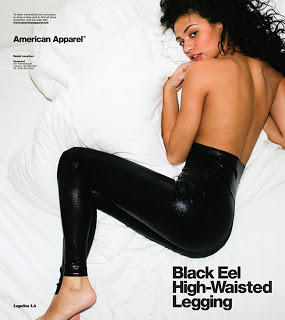Introduction
In his documentary, Jhally (2009) elaborates on the notion of codes of gender proposed by the sociologist Erving Goffman. It is stated that modern advertisement exemplifies these codes in an extremely strong manner (Jhally, 2009). This paper demonstrates that many ads use these codes nowadays by providing several examples of such ads.
Example 1
An advertisement for Sun-Maid snacks (see Figure 1 below) is an example of an ad that depicts females in a manner described by Goffman (as cited in Jhally, 2009). The woman in the image is shown in a pose that makes her vulnerable and defenseless, which corresponds to the notion of ritualization of subordination. Even though the female is doing exercise, a vulnerable pose, instead of one that suggests power, is chosen. The woman also seems to be oblivious of her surroundings, being absorbed in her activity instead, which is an example of licensed withdrawal. Also, she wears a children’s red hat, which infantilizes her.

Example 2
Figure 2 below is an advertisement for female leggings. The woman portrayed in the image is lying on some furnished bed in a defenseless and subordinate posture, which is simultaneously sexually inviting; this is an instance of ritualization of subordination (Jhally, 2009). She is gently touching her body, rather than holding something in a firm grip; her touch is definitely “feminine” (Jhally, 2009). Therefore, this advertisement also corresponds to Goffman’s notions (as cited in Jhally, 2009).

Example 3
The advertisement in Figure 3 below is that of a wedding cake. The cake is held by a female, whose grip is gentle; the cake appears to be resting in her hands rather than being held by them. This corresponds to the notion of the feminine touch (Jhally, 2009). At the same time, the woman is standing in a posture that is not assertive; she seems to gently and unobtrusively offer the cake to the audience. Her dress has open shoulders, and her arms are not covered by clothes as well. Her mouth is slightly open as if to be sexually inviting. These features may serve as an example of the ritualization of subordination as well (Jhally, 2009).

Example 4
In Figure 4 below is that of a jacket for males. In contrast to the females shown in the images above, who may serve as an example of the notion of licensed withdrawal (Jhally, 2009), the man wearing the jacket is not withdrawn from his surroundings. He looks directly at the camera, his gaze is focused and intent. His head is tilted downwards, suggesting that the man is alert and prepared to face a possible challenge. Even his stance suggests that he is ready for such a challenge: his hands are lowered, but ready to be raised in a fraction of a second; his body does not face the camera directly but is turned at an angle that is similar to an angle at which a melee fighter’s body is turned towards that fighter’s opponent. He is not smiling; his facial expression is careful and controlled. He shows confidence, power, and control, thus exemplifying the codes of masculinity as discussed by Jhally (2009).

Conclusion and Implications
Therefore, at least some of today’s advertisements utilize the “codes of gender.” The examples provided above confirm this statement. It should also be noted that, as Jhally (2009) suggests, all these ads do not even appear strange from the first glance, demonstrating that Goffman’s notions are indeed embedded in today’s culture.
There is a multitude of implications of this conclusion. For instance, in today’s society, the “codes of gender” are still perceived as the norm, for the images above do not seem strange from the first glance. Such normalization means that, for instance, people who do not fit either the “male” or the “female” category may be viewed as not-normal, which may hurt their lives. Also, women are expected to follow their gender roles, which they often learn from childhood; but this might have adverse consequences for them, as they are viewed as defenseless and submissive. Finally, men are expected to be strong, independent, and self-reliant, which may put additional pressure on them.
References
Fuji Colour Block Hooded Jacket. (n.d.). Web.
Jhally, S. (Director). (2009). The codes of gender[Video file]. Web.
Pat Benatar: Style in spandex – before American Apparel made it trendy [Blog post]. (2011). Web.
Sun-Maid gets surreal. (2010). Web.
Trend alert: Dark wedding cakes. (2017). Web.